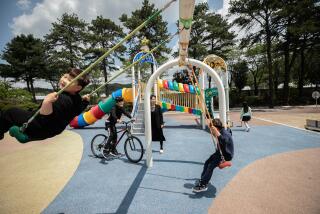1st Step Taken to Offer Child Care for All : Government: Under an evolving master plan, children whose parents live or work in the city would be eligible for affordable, quality care.
- Share via
The Santa Monica city government, Santa Monica College and the local school district have launched an ambitious joint effort aimed at establishing affordable, quality child care that would be available to everyone who lives or works in Santa Monica.
The City Council took the lead Tuesday night by approving the first phase of a Child Care Master Plan. Among other things, it calls for the city, the college and the Santa Monica-Malibu Unified School District to jointly create and adopt a child-care policy and an overall plan for reaching the goal of a citywide program.
The commitment by the three public agencies to pool their resources to create the program--a process that is expected to take about 10 years--was applauded by several rows of parents and wriggling children who attended the council meeting.
Considerable research already has been conducted on the issue. A recent study by a consulting team found the demand for child care to be three times the supply. The study also found that the majority of child care is used by non-residents who work in Santa Monica.
“The child-care spaces which exist in our area do not come near meeting the demand,” said Suzanne Abrescia, director of a private preschool in Santa Monica. “These days, in order to obtain a child-care space, a parent has to reserve a slot before the child is even born.”
Terry Ogawa, executive director of Connections for Children, the local child-care resource and referral agency, said there is a two-to-five year waiting list for child care in Santa Monica. She called the city’s action a “godsend” at a time when child-care dollars are being cut from state and federal budgets.
Kate Vernez, a senior management analyst for the city who presented the findings to the council, said parents run into difficulty when they have to find the right location, price and type of child care.
“It gives you an idea of how complex arrangements have become,” she said. “We found that parents were so concerned with logistics, quality came second.”
Of the parents surveyed, most preferred licensed child care, but because of a shortfall, they relied on informal care. At present, 70% of care for infants and toddlers is informal.
Nearly half of the working parents who were surveyed said they had trouble finding convenient child-care locations.
The study found that there is an increasing need for infant and toddler care, as well as care for school-age children. It also found a wide need for specialized types of care, such as for sick children, children out of school on vacation, and after-school care for older children.
Under the master plan, Vernez said, it is envisioned that it will take about 10 years to implement a citywide program that fully meets the need for child care. The city has included more than $400,000 in its proposed 1991-92 budget to implement the first steps of the plan.
Future funding for the program, however, will require help from the federal government or passage of a voter-approved initiative.
The first phase of implementation includes building a core of private-sector benefactors and providers of child care; increasing the number of qualified child-care professionals, and identifying new locations for child care.
“What excites me about this plan is that we’re taking on the challenge of breaking new ground,” said Mayor Judy Abdo. “It’s for the good of all of us.”
Staff writer Julio Moran contributed to this story.
More to Read
Sign up for Essential California
The most important California stories and recommendations in your inbox every morning.
You may occasionally receive promotional content from the Los Angeles Times.










